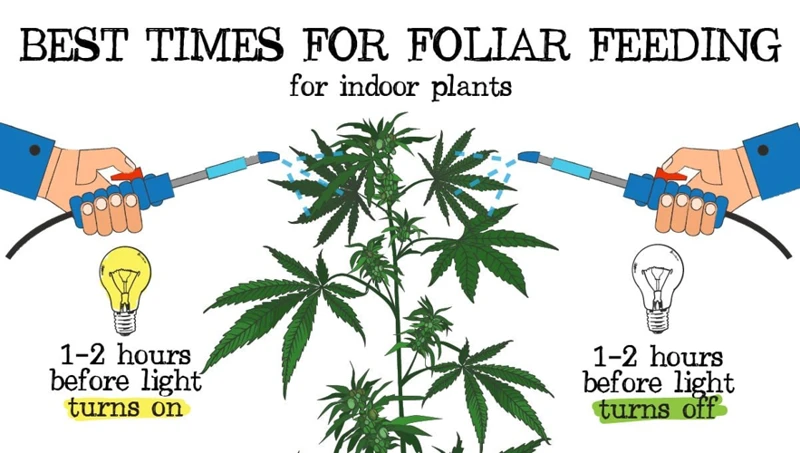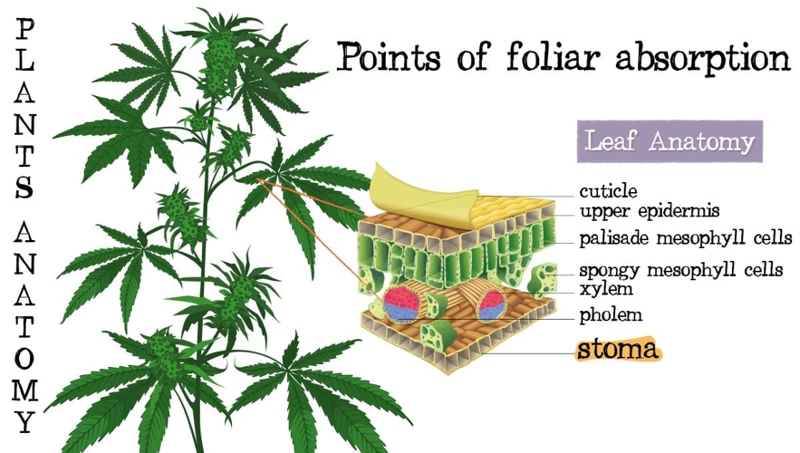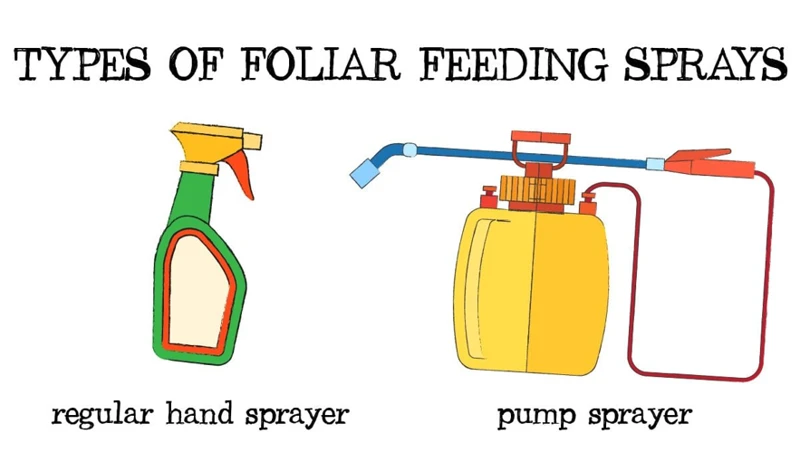
Make Your Own Nutrient Mixtures for Cannabis Plants
Introduction
Contents
Are you looking for an effective and natural way to boost your cannabis plants’ growth and yield? DIY foliar sprays might just be the solution you need. By applying nutrient-rich mixtures directly to the leaves, you can improve nutrient absorption, increase growth, and even ward off pests. In this article, we’ll explore the benefits of DIY foliar sprays and share some easy-to-follow recipes for creating your own nutrient mixtures. Plus, we’ll provide tips and precautions for properly applying foliar sprays to ensure optimal results.
What is a foliar spray?
Foliar spray is a technique of applying nutrients directly to the leaves of plants. In this method, a liquid mixture of nutrients is sprayed on the leaves of the plants till they’re wet. The nutrients mix is absorbed through the stomata or openings on the leaves, allowing them to take in nutrients faster than by roots.
| Technique: | Foliar spray |
| Application method: | Applying liquid mixture directly to the leaves of plants |
| Nutrient absorption: | Absorbed through stomata on the leaves |
| Speed of absorption: | Faster than by roots |
Foliar spraying has become an increasingly popular method among cannabis growers because it helps in improving the quality of the plant, including growth and yield, and protects them from pests and diseases. There are several types of foliar sprays available in the market, but many growers prefer to make their nutrient mixtures using organic and natural ingredients.
Why use DIY foliar sprays?
DIY foliar sprays are a cost-effective and natural way to provide your cannabis plants with necessary nutrients and boost their growth and health. Here are some reasons why you might consider using them:
- Commercial nutrient solutions can be expensive and may contain synthetic chemicals or preservatives that can be harmful to the plants and the environment. By making your own foliar sprays from natural ingredients, you can ensure that your plants are getting a sustainable and healthy source of nutrients.
- Foliar sprays can be applied directly to the leaves and absorbed more quickly than nutrients applied to the soil. This makes them a great option for providing a quick boost of nutrients or addressing any nutrient deficiencies that may arise.
- If you’re growing cannabis plants indoors or in a greenhouse, you may not have access to natural sources of nutrients that outdoor plants would normally get from the soil. DIY foliar sprays can help supplement for this lack of access to natural nutrients.
- Foliar sprays can also act as natural pest repellents, which can prevent the need for harsh chemical pesticides that can be harmful to the plants and the environment.
DIY foliar sprays are an accessible, natural, and cost-effective way to provide your cannabis plants with the nutrients and care they need to grow and thrive.
Benefits of DIY Foliar Sprays
After learning about what foliar sprays are and why they are beneficial for cannabis plants, you might be wondering what specific benefits DIY foliar sprays can bring to your plant growth. Luckily, there are numerous advantages to using DIY foliar sprays. By creating your own nutrient mixtures, you can customize the ingredients to your plant’s specific needs and preferences. Not only can DIY foliar sprays improve nutrient absorption for better growth and yield, but they can also act as a natural pest control method. Let’s take a closer look at the benefits that DIY foliar sprays can offer for your cannabis plants.
Improved nutrient absorption
One of the main benefits of using DIY foliar sprays on cannabis plants is the improved nutrient absorption they provide. When nutrients are applied to the soil, they must be absorbed by the roots before they can be distributed to the rest of the plant. However, not all nutrients are immediately available to plants, and certain soil conditions or factors may prevent them from being absorbed efficiently.
With foliar sprays, nutrients are applied directly to the leaves of the plant using a mist or spray. This bypasses the traditional absorption process through the roots and allows the plant to quickly and easily absorb the nutrients. Additionally, because the nutrients are directly applied to the leaves, it can also address any deficiencies that may not be easily remedied through soil amendments.
The effectiveness of foliar sprays in improving nutrient absorption can be further enhanced by combining them with other products. For example, adding a surfactant to the spray solution can help break down the surface tension of water droplets, allowing them to spread over the leaf surface more easily and be more readily absorbed into the plant’s tissue. Similarly, adding a natural plant-based adhesive can help the nutrient solution stick to the leaves for longer, prolonging its effectiveness.
Some of the best nutrients to include in foliar sprays for improved absorption include micronutrients like iron, magnesium, and zinc, which are essential for plant growth and development. Additionally, using natural sources like worm castings, seaweed, and compost tea can provide a wide range of micronutrients in a form that is easily absorbed by the plant.
By using DIY foliar sprays to supplement soil nutrition, growers can ensure their cannabis plants receive the necessary nutrients for optimal growth and development.
Increased growth and yield
One of the biggest benefits of using DIY foliar sprays on cannabis plants is the increased growth and yield that they can provide. Through the use of natural and nutrient-rich ingredients, these sprays can help to promote healthy plant growth and higher crop yields.
Here are some of the ways that DIY foliar sprays can help to increase growth and yield:
| Benefit | Explanation |
|---|---|
| Stimulates photosynthesis | The natural ingredients in foliar sprays can help to stimulate photosynthesis, which is the process by which plants convert sunlight into energy. By promoting this process, foliar sprays can help to increase the overall growth and health of the plant. |
| Improves nutrient absorption | Foliar sprays can help plants to absorb nutrients more easily, which can lead to faster growth and higher yields. When applied directly to the leaves, these sprays allow the plant to take in essential nutrients through its stomata, which are the small openings on the leaves. |
| Boosts immune system | Many DIY foliar sprays contain natural ingredients that can help to boost the plant’s immune system, making it more resistant to disease and pests. By keeping the plant healthy and strong, foliar sprays can help to ensure optimal growth and yield. |
| Enhances stress tolerance | Some plants may become stressed due to environmental factors such as extreme temperatures, drought, or excessive sunlight. DIY foliar sprays can help to enhance the plant’s stress tolerance, allowing it to better handle these adverse conditions and ultimately leading to better growth and yields. |
By incorporating DIY foliar sprays into your cannabis cultivation routine, you can help your plants to reach their full potential in terms of growth and yield.
Natural pest control
Foliar sprays are not only great for providing nutrients to cannabis plants, but they can also serve as a natural pest control method. Using DIY foliar sprays allows you to avoid using chemical pesticides which can harm both your plants and the environment. Here are some natural pest control options you can include in your DIY foliar sprays:
- Neem oil: Neem oil is a popular natural pesticide that comes from the seeds of the neem tree. It is effective against a variety of pests including spider mites, aphids, and whiteflies. To use neem oil in your foliar spray, mix 1 teaspoon of neem oil with 1 quart of warm water and add a few drops of dish soap. Shake well before applying to your cannabis plants.
- Garlic: Garlic is a natural insecticide and repels many pests such as spider mites, aphids, and thrips. To make a garlic foliar spray, crush a few garlic cloves and steep them in hot water for 24 hours. Strain the garlic pieces out and add 1 tablespoon of the liquid to 1 quart of water. You can also add a few drops of dish soap to help the solution stick to your plants.
- Chrysanthemum flowers: Chrysanthemum flowers contain a natural insecticide called pyrethrum, which is effective against many pests including spider mites, thrips, and whiteflies. To make a chrysanthemum foliar spray, steep a handful of chrysanthemum flowers in hot water for several hours. Strain the flowers out and use the liquid to spray your cannabis plants.
By incorporating these natural pest control methods into your DIY foliar sprays, you can protect your cannabis plants from pests without harming the environment or your plants. However, it’s important to note that foliar sprays should not be used as the sole method of pest control, and it is always best to practice proper plant maintenance and hygiene to prevent pest infestations in the first place.
DIY Foliar Spray Recipes
Are you ready to make your own nutrient mixtures for your cannabis plants? Here are some easy and effective DIY foliar spray recipes to try. These recipes include natural and organic ingredients that are readily available and affordable. By using these recipes, you can ensure that your plants are getting the nutrients they need to thrive, without relying on expensive commercial fertilizers. So, roll up your sleeves and let’s get started with these simple and effective DIY foliar spray recipes.
Recipe 1: Compost tea and kelp
One simple and effective DIY foliar spray recipe involves using compost tea and kelp. This combination provides a rich source of nutrients for cannabis plants, promoting healthy growth and development.
Ingredients:
| Ingredient | Amount |
|---|---|
| Compost Tea | 2 cups |
| Kelp Extract | 1 tablespoon |
| Water | 2 cups |
Instructions:
1. In a large bowl, mix 2 cups of compost tea with 1 tablespoon of kelp extract.
2. Add 2 cups of water, and stir the mixture until it is well combined.
3. Pour the mixture into a spray bottle, and shake it well to ensure the ingredients are thoroughly mixed.
4. Spray the mixture generously onto your cannabis plants, making sure to cover the leaves and stems.
5. Repeat once a week for optimal results.
By using this foliar spray recipe, your cannabis plants will be provided with a wide range of essential nutrients, including nitrogen, phosphorus, and potassium, as well as trace minerals like zinc, iron, and manganese from the kelp extract. This will help to promote healthy growth, reduce stress, and increase overall yield.
Recipe 2: Epsom salt and baking soda
If you’re looking for a simple and inexpensive DIY foliar spray recipe, try using Epsom salt and baking soda. Epsom salt is a great source of magnesium, which is essential for plant growth and development, while baking soda can help regulate the pH levels of the plant’s leaves. Here’s how to make the mixture:
- Ingredients:
- 1 tablespoon Epsom salt
- 1 teaspoon baking soda
- 1 quart of water
- Instructions:
- Dissolve the Epsom salt and baking soda in the water.
- Fill a spray bottle with the mixture.
- Shake well and spray evenly on the plant’s leaves.
When spraying your plants, make sure to cover the tops and bottoms of the leaves, as well as the stems. This foliar spray can be used every two weeks or as needed, but be careful not to overdo it. Too much magnesium can be harmful to your plants.
This DIY foliar spray can be particularly helpful for cannabis plants, which require high levels of magnesium for healthy growth. By making your own nutrient mixture, you can save money and customize the recipe to your plant’s specific needs.
Recipe 3: Worm castings and fish emulsion
Combining worm castings and fish emulsion can be an effective foliar spray for cannabis plants. Worm castings provide a rich source of organic matter and beneficial microorganisms while fish emulsion is high in nitrogen, phosphorus, and potassium.
To make this foliar spray, follow these steps:
- Mix 2 tablespoons of worm castings with 2 tablespoons of fish emulsion in a gallon of water.
- Stir well to ensure the ingredients are evenly mixed.
- Transfer the mixture to a spray bottle or pump sprayer.
- Apply the foliar spray to your cannabis plants.
It is important to note that this mixture can have a strong odor, so it is best to use it outdoors or in a well-ventilated area. Additionally, be sure to test the spray on a small section of your plants before applying it to the entire plant to ensure it doesn’t cause any adverse effects.
Using a foliar spray made of worm castings and fish emulsion can provide your cannabis plants with nutrients essential for healthy growth, resulting in larger and more vigorous plants.
How to Apply Foliar Sprays
Applying foliar sprays may seem like a straightforward process, but there are some key considerations to keep in mind to ensure maximum effectiveness and avoid any potential damage to your plants. In this section, we’ll cover when and how to apply foliar sprays, as well as some precautions to take to ensure the health of your plants. So, let’s delve into the intricacies of applying foliar sprays and get your cannabis plants on their way to optimal health and growth!
When to apply foliar sprays
Foliar sprays are a great way to give your cannabis plants a boost of nutrients and protect them from pests. However, it is important to apply these sprays at the right time to ensure maximum benefit.
Timing is everything when it comes to foliar sprays. The best time to apply them is during the vegetative stage of growth, when the plant is actively producing new growth. This is because the leaves are most receptive to receiving nutrients and can take them up quickly.
Avoid applying foliar sprays during the flowering stage, as this can interfere with the natural flavor and potency of your buds. It is also important to avoid applying foliar sprays during the heat of the day, as the sun can cause the leaves to burn.
It is recommended to apply foliar sprays in the early morning or late evening when the temperature is cooler and the moisture can be absorbed more easily. This will also give the plant time to absorb the nutrients before sunlight exposure.
Here is a table summarizing when to apply foliar sprays:
| Stage of Growth | Best Time to Apply | Avoid Applying During |
|---|---|---|
| Vegetative | Early morning or late evening | Flowering stage and heat of the day |
| Flowering | N/A – avoid | N/A – avoid |
Keep in mind that every cannabis strain is different and may have different needs. It is important to do research on your specific strain and adjust your foliar spray application based on its individual needs.
How to apply foliar sprays
To properly apply foliar sprays to your cannabis plants, follow these steps:
- Timing: The best time to apply foliar sprays is early in the morning or in the evening when the temperatures are cooler and the sun is less intense. Avoid spraying during the hottest part of the day.
- Cleanliness: Make sure your spraying equipment is clean to prevent the spread of diseases or pests. Use clean, filtered water to mix your foliar spray solution.
- Mixing: Mix your foliar spray solution according to the recipe you’ve chosen. Make sure to thoroughly dissolve any powders or salts in the mixture.
- Testing: Before applying the spray to your entire plant, test it on a small section first to make sure your plants don’t have an adverse reaction.
- Application: Apply the foliar spray gently to the tops and bottoms of the leaves with a fine-mist spray bottle or sprayer. Avoid getting the solution on the buds and flowers, as this can affect their taste and potency. Be sure to cover the entire plant for even application.
- Drying: Allow your plants to dry naturally after applying the spray. Avoid rinsing off the spray after application as this can decrease its effectiveness.
By following these steps, you can ensure that your DIY foliar spray is applied correctly and effectively to your cannabis plants, leading to improved nutrient absorption, increased growth and yield, and natural pest control.
Precautions when using foliar sprays
It is important to take certain precautions when using foliar sprays on cannabis plants. Here are some tips to keep in mind:
- Wear protective gear: Always wear gloves, protective glasses, and a mask when preparing and applying foliar sprays. Some of the ingredients used can be irritating to the skin, eyes, and respiratory system.
- Test on a small area: Before applying any foliar spray to the entire plant, test it on a small area and wait for a few days to see if the plant shows any adverse reactions.
- Avoid spraying during hot or sunny weather: Applying foliar sprays during hot or sunny weather can cause the liquid to evaporate quickly and damage the leaves.
- Apply during the early morning or late evening: The best time to apply foliar sprays is during the early morning or late evening when the temperature is cooler, and the sun is less intense.
- Avoid spraying directly on flowers or buds: When applying foliar sprays, avoid spraying directly on flowers or buds to prevent the buildup of moisture and potential mold issues.
- Store leftover foliar sprays properly: If you have any leftover spray, store it in a sealed container in a cool, dark place away from children and pets.
By following these precautions, you can ensure that your cannabis plants get the benefits of foliar sprays without any negative side effects.
Conclusion
After learning about the benefits of DIY foliar sprays and exploring some recipes to try, you may be eager to get started on your own. DIY foliar sprays can provide your cannabis plants with added nutrients and protection, leading to healthier growth and higher yields.
However, it’s important to remember that foliar sprays should not be used as a replacement for a proper feeding regimen. They should be used in conjunction with a balanced nutrient schedule for best results.
When making your own foliar sprays, be sure to use quality ingredients and follow the recipes carefully. Pay attention to the types and amounts of nutrients you are adding to avoid over-fertilization or nutrient burn.
Additionally, when applying foliar sprays, always take precautions to protect yourself and your plants. Wear protective clothing and use a respirator when spraying to prevent inhalation of harmful substances. Apply sprays during the appropriate times and in moderate amounts to avoid damaging your plants.
In conclusion, DIY foliar sprays can be a valuable addition to your cannabis maintenance routine. By carefully selecting and applying nutrient-rich mixtures, you can improve the health, growth, and yield of your plants. Use caution and follow best practices to ensure the safety of yourself and your plants.
Frequently Asked Questions
What are some common nutrients used in DIY foliar sprays?
Some popular nutrients used in DIY foliar sprays include compost tea, kelp, Epsom salt, baking soda, worm castings, and fish emulsion.
Can foliar sprays replace regular watering and feeding?
No, foliar sprays should be used in addition to regular watering and feeding as a supplement to promote plant growth and health.
Do I need a special sprayer for foliar spraying?
It is recommended to use a sprayer specifically designed for foliar spraying, as it will distribute the spray evenly and minimize waste.
How often should I apply foliar sprays?
This depends on the recipe and the stage of growth of your plants. Some sprays can be applied weekly, while others may only be needed every few weeks.
Can I make my own compost tea for foliar spraying?
Yes, compost tea is a popular ingredient in many DIY foliar spray recipes, and can easily be made at home using compost and water.
Will foliar sprays harm my plants if applied too frequently?
Yes, overuse of foliar sprays can damage plant leaves and roots, so it is important to follow any specific instructions or recommended application frequencies for each recipe.
Are there any natural alternatives to chemical fertilizers for foliar spraying?
Yes, many homemade foliar spray recipes use natural ingredients like compost tea, worm castings, and fish emulsion as alternatives to synthetic fertilizers.
Can I use household products to make my own foliar spray?
Yes, ingredients like baking soda and Epsom salt, which are commonly found in households, can be used to make effective DIY foliar sprays.
Are foliar sprays effective in controlling pests?
Some foliar sprays, particularly those that contain neem oil, can help to control pests naturally, although they may not be as effective as chemical pesticides.
Can I foliar spray during flowering?
It is generally recommended to avoid foliar spraying during the flowering stage, as it can disrupt the production of buds and flowers.





